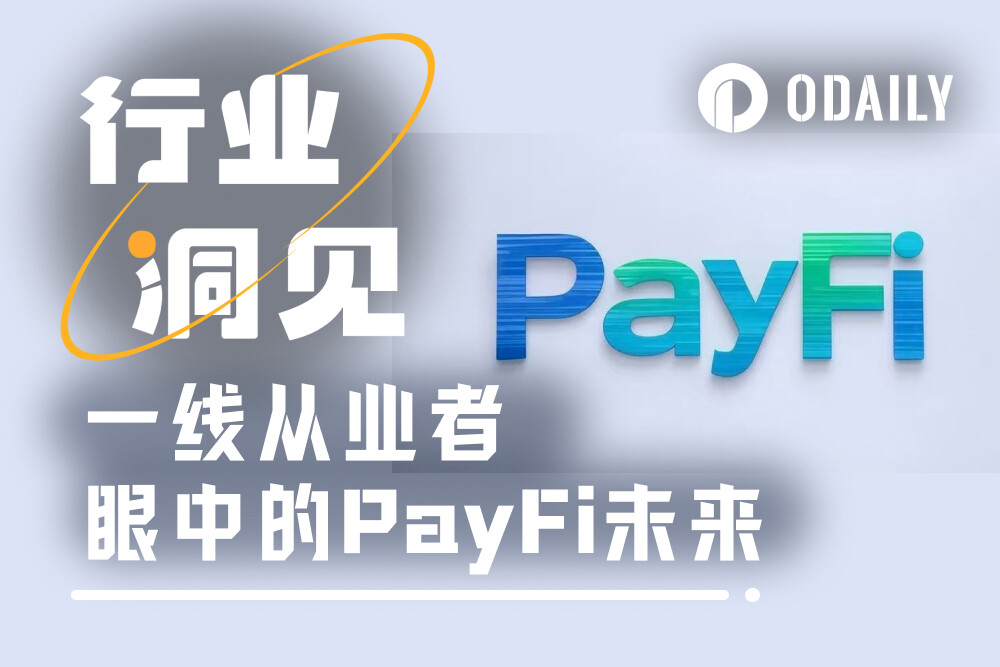Odaily Exclusive Interview | Is U Card Dead? How Can the PayFi Project Survive?
- 核心观点:PayFi赛道呈现多元化发展路径。
- 关键要素:
- U卡与扫码支付模式并存。
- 监管合规是最大挑战。
- B端先行,C端为长期目标。
- 市场影响:推动加密支付大规模普及。
- 时效性标注:长期影响。
Original | Odaily Planet Daily ( @OdailyChina )
By Wenser ( @wenser 2010 )
In 2025, stablecoins have become a highly anticipated source of cash flow in the crypto industry, and the closely related PayFi track has also attracted active participation from multiple parties: whether it is crypto-native projects, payment industry giants, stablecoin issuers, cryptocurrency exchanges, or stablecoin public chains, they are all actively making plans in their own way, striving to seize the initiative in the development of the PayFi track.
Against this backdrop, Odaily Planet Daily interviewed several frontline PayFi professionals during the Token2049 event in Singapore in early October. Through these conversations, we discovered that PayFi's future remains full of possibilities. The following content is compiled from these interviews, with some information adjusted to accommodate the flow and length of the article.
The PayFi Industry Paradox: Is the U-Card the Path to Mass Adoption?
When it comes to PayFi, many people's first impression is probably the U card. Previously, Infini was forced to discontinue its U card business due to its lack of popularity, sparking heated market discussion ( recommended reading : "Exclusive Interview with Infini Co-founder: Why We Shut Down the U Card Business?" ).
At the Token2049 event, when asked whether they were optimistic about the U-card business development model, many practitioners gave different answers.
Roger, a marketing representative from DeCard, told Odaily Planet Daily that, thanks to its local payment license in Singapore, Decard has seen varying degrees of growth in both card issuance and user numbers. The compliance advantages accumulated over its long-term business operations have also enabled Decard to avoid building its own application channels and user network from scratch, leveraging the user networks of traditional payment giants like Visa and Mastercard, as well as those of traditional banks, to build a corresponding payment network. He also stated that he still considers U Card a key segment of his business.
But some people gave the opposite answer.
BenPay's Pearce Chen told Odaily Planet Daily: "In addition to relying on traditional U-card business from payment institutions such as Visa and Mastercard, we have adopted a more forward-looking solution of 'QR code + POS machine or app scanning' to solve payment needs. This allows direct payment in stablecoins, which are deducted to the local clearing network and converted into fiat currency. This is equivalent to kicking out upstream card issuers such as Visa and Mastercard and instead building our own payment application channels and user network. Since we want to pay with stablecoins, why should we still rely on the traditional payment institutions we are trying to disrupt?"
From this perspective, BenPay's approach is more crypto-native. Unlike Decard's "grafting" approach, BenPay has chosen the more challenging path of building a PayFi network from scratch. Furthermore, according to Pearce Chen, another key focus of BenPay is the development of tools for DeFi protocols. Combining its Benfen payment public chain and self-hosted wallet, BenPay aims to simplify the complex DeFi protocols, making it easier for traditional users to enjoy DeFi benefits.
Coincidentally, Ellipay also focuses on providing payment gateways through POS hardware. Ellipay Product Director LX explained that Ellipay's current POS terminals already support offline purchases; with a simple tap, stablecoin transfers like USDT/USDC can be completed in seconds.
Ellipay POS payment demonstration site
Faced with the numerous barriers imposed by traditional card issuers, the cryptocurrency industry's PayFi project has chosen to circumvent these restrictions by making changes to the hardware entry point, allowing PayFi to gradually penetrate various life and consumer scenarios. This is especially true in overseas markets, where card payments are common, where POS payments remain a commonplace consumption model for many.
After all, the overseas market does not have a one-stop payment app like WeChat Pay and Alipay in China that can realize payment and collection operations with the help of QR codes.
Ellipay Product Director LX also mentioned, "PayFi is undoubtedly a valuable and profitable business. While profit distribution will indeed be concentrated upstream (such as stablecoin issuers), we see more opportunities downstream compared to other sectors. This is because the crypto payment sector represented by PayFi is a super-sector with extremely diverse user scenarios. Unlike all previous crypto sectors, its user scenarios and needs are diverse. We cannot view it through the lens of traditional payments, because in the PayFi sector, the value distribution model of payments will undergo a fundamental transformation: the value of the application layer will no longer be limited to payment pipeline fees, but will derive from the additional services it creates for highly independent users (such as integrated DeFi income, social finance functions, programmable currency applications, etc.). These services will constitute the core growth pole of future downstream profits."
It has to be said that considering the current limited project development model, PayFi's business model still has strong scalability and more possibilities.
Challenges and opportunities in the PayFi industry: regulatory arbitrage, user education, and underlying infrastructure
In addition to existing businesses, Odaily Planet Daily also discussed with practitioners the biggest challenges facing the PayFi industry.
BenPay Business VP Pearce Chen systematically shared his views. He believes that the PayFi industry currently faces three major challenges:
First, the biggest challenge is regulatory compliance. While PayFi projects can implement Know Your Customer (KYC) and Know Your Business (KYB) requirements for payment transactions, no national laws clearly define or regulate the interest earned on user stablecoin assets. Essentially, PayFi projects exploiting this interest generation constitute regulatory arbitrage, and regulatory requirements for fund management vary across different regions and national laws.
Secondly, there's low consumer adoption. Currently, only crypto investors and some cross-border businesses use stablecoins for transactions. 95% of Chinese people aren't even aware of stablecoins, and even Bitcoin is only a passing familiarity. This lack of user education is a major obstacle to the widespread adoption of PayFi. This requires relevant products and a strong penetration rate. It might even require a similarly popularized platform, like WeChat red envelopes.
Finally, over-reliance on the existing payment system and the inadequacy of underlying infrastructure also pose significant challenges for PayFi. Currently, the operation of PayFi products remains heavily reliant on the Swift settlement system, the traditional banking system, and US dollar funding positions. Any industry-wide innovation requires integration with various VA accounts and underlying systems. Furthermore, banks, as the lifeblood of the PayFi industry, hold the power of life and death – they can arbitrarily block accounts, leaving PayFi projects with no recourse. Countless PayFi projects have diligently pursued seemingly insignificant innovations, essentially attempting to prove they are businesses, not money laundering. Yet, they continue to face structural pressure from regulators and the banking system.
When discussing the PayFi project's business model, Pearce Chen emphasized that the true competitive barrier in the PayFi industry often comes from the development of large-scale infrastructure and underlying protocols. Payments themselves may not be profitable, so projects must accumulate assets and establish a closed-loop financial management ecosystem to generate revenue. Just like Alipay would have struggled to succeed without Yu'ebao, one cannot simply assume everything is secure by integrating with numerous underlying banking systems or major blockchain networks; such a business would be extremely burdensome. In contrast, BenPay chose to build its own blockchain network from scratch. User deposits of stablecoins from various blockchain networks are automatically mapped to corresponding smart contracts, converted into BUSD, and supported for both consumption and financial management. This significantly simplifies the user experience and entry-level requirements, which is crucial for subsequent product promotion and market adoption.
“The ultimate logic of the payment industry is that whoever can build a cheap and high-performance public chain and provide a better user experience will be the one users vote with.”
Currently, Ethereum and Solana hold a certain precedence due to their security and low costs, respectively. However, in the near future, any high-performance public chain has the potential to drive the large-scale adoption of PayFi—it doesn't even need to be highly decentralized; it just needs to reduce costs and increase efficiency to meet the needs of both B2B and B2C users.
This viewpoint was also echoed by Ellipay Product Director LX. Regarding the "Challenges of the PayFi sector," he stated, "Like many other crypto sectors, PayFi faces three core challenges in its widespread adoption: First, fund security is the cornerstone. The safety of user assets is the premise of any business model, which directly relies on the iteration of underlying technology and the refinement of product design. Second, regulatory compliance presents global structural contradictions. PayFi is inherently global, but its ideal of unified services naturally conflicts with the current regulatory landscape. The solution lies in seeking global regulatory collaboration. Finally, user awareness and penetration are fundamental bottlenecks. After more than a decade of cryptocurrency development, user penetration remains at only 5%-10%, and very few of these users possess the sophisticated financial knowledge required for PayFi. Breaking this bottleneck may depend on the emergence of a "super app" that fundamentally lowers the barrier to entry with an ultimate user experience."
Finding a balance between asset security, global regulation, and user awareness is a crucial question that must be addressed between all PayFi projects and global adoption.
The short-term and long-term battle in the PayFi industry: the phased trade-off between B-side and C-side businesses
In addition, for projects in the PayFi industry, business focus is also an unavoidable trade-off.
In the current industry landscape, despite the more active demand from consumer users, business-to-business (B2B) remains the primary focus of most PayFi projects due to factors such as the market's development stage. After all, compared to institutional clients with transaction volumes often exceeding tens, hundreds, or even billions of dollars, consumer users' needs are more fragmented, and to some extent, can even be described as a thankless task.
However, according to Odaily Planet Daily's discussions with various industry insiders, while PayFi was initially viewed by industry insiders as a cash flow business focused more on B-side users, in the long run, consumer user demand remains the mainstream market and the focus of development. Generally speaking, the development of the PayFi project can be divided into the following three stages:
Initial project phase: The focus is on B2B services. During this phase, PayFi projects need to ensure cash flow and secure a competitive edge. Currently, truly profitable companies are focused on the B2B sector, such as Huma Finance, a leading PayFi project within the Solana ecosystem. Consumer services, on the other hand, tend to focus on traffic marketing and brand building.
Mid-term project: Equal emphasis on both the B-side and the C-side. When the PayFi project reaches a certain stage of development, it needs to ensure a smooth transition from "survival" to "relatively successful" development. This requires the project team to implement a "two-legged approach": the B-side business generates continuous cash flow to support business operations; the C-side business continuously expands the user market and increases the user base to ensure future development.
Late-stage projects: Focus on consumer-end services. Long-term, all PayFi projects aim to become unicorns or even monopolistic giants, similar to mobile payment giants like WeChat, Alipay, and PayPal. Supporting this goal undoubtedly relies on the large-scale consumer-end market, which has a higher frequency of transaction and payment demands.
From "surviving", to "living better", and finally to "surviving to the end", to becoming the industry winner with the last laugh, the PayFi project has a long way to go. Both the B-end institutional market and the C-end retail market are indispensable.
The future of PayFi lies in the repeated transfer needs
At the end of the article, the author would like to say a few words about the current industry difficulties.
On the one hand, there are more and more types of stablecoins in the cryptocurrency market, but for most people, the costs and scenarios of stablecoin transfers, payments, and transactions have not changed significantly; on the other hand, there are still billions of people in the world who still do not have their own bank accounts, or are facing tremendous survival pressure from the rapid depreciation of local fiat currencies and inflation.
In my opinion, the future of the PayFi industry shouldn't be limited to the fluctuating numbers on cryptocurrency exchanges. It must transcend the cryptocurrency market and reach every household around the world, permeating the capillaries of the global economy, encompassing every aspect of life, from food, clothing, housing, and transportation. It's through these repeated transfer needs that the PayFi industry can find its most loyal fans and bring its efficient and convenient user experience to billions of ordinary people.
By then, PayFi will not be the dream of one person or one project, but an indispensable part of the real lives of countless people.




